Читать книгу Individual Participant Data Meta-Analysis - Группа авторов - Страница 72
Box 4.1 Key sections to include in an IPD meta‐analysis protocol
ОглавлениеThe rationale, including reference to any prior motivating systematic review or meta‐analysis, and why IPD are needed
A description of the research objectives
The inclusion and exclusion criteria relating to participants, interventions, comparisons, outcomes and study design types (i.e. PICOS), including whether these will be applied at the trial level or participant level, and any other factors such as the qualifying dates for trial completion
A summary of the methods used for trial identification, including bibliographic search strategies and any additional means of identifying eligible trials, such as communication with trial investigators, along with information about the screening process
A description of how IPD received will be checked and verified, and how trial quality and the risk of bias will be assessed based on the IPD
Details of the participant‐level variables to be collected
A list of main and additional outcomes and their definitions
A summary of the statistical approaches and models to be used, both for analysing trials separately (if applicable) and for IPD meta‐analysis, including details of methods for: accounting for clustering of participants within trials, quantifying and exploring heterogeneity, modelling participant‐level variables (and any interactions), and any sensitivity analyses. These should be specified in sufficient detail in the protocol or in a separate statistical analysis plan (SAP), in order to permit scrutiny and, if necessary, replication (through access to the same IPD)
An initial power calculation or sample size justification, conditional on assuming IPD are available from particular trials
An approximate timetable for the project
Details of members of the central research team, the project advisory group or steering committee, patient and public involvement representatives and funders
A dissemination plan
A provisional table of eligible studies
Appendices of, for example, search strategies for individual databases and the data dictionary
Source: Jayne Tierney and Lesley Stewart.
As for other clinical studies, an additional statistical analysis plan (SAP) may be required, in which case, the protocol should focus on the general methods and a summary of the planned analyses, whilst the SAP would provide more detailed explanation of statistical methods and modelling techniques (see guidance in Part 2). The anticipated scale and complexity of the project will help guide whether the protocol is sufficient, or whether an additional SAP is needed.
Although the protocol and SAP should pre‐specify the analyses in some detail, this does not preclude analyses that become necessary to further explore, explain, or add to the main findings. The protocol should make it clear that such analyses may be needed, and will be labelled as post‐hoc or exploratory in any report or publication, to distinguish them clearly from planned per‐protocol analyses. Furthermore, what is planned at the outset may need to be modified according to, for example, emerging information about data availability (including variables recorded in each trial’s IPD), or the identification of new factors that may be prognostic or interact with a treatment effect. Therefore, it can be useful to produce several versions of the protocol and/or SAP, to allow for the incorporation of new proposals and suggestions, either from the project advisory group or trial investigators, or to deal with issues of data availability. Given the inevitable concerns about independence of trial investigators and potential conflicts of interest, it is important to maintain a date‐stamped log of such protocol amendments, including who proposed and sanctioned any substantive ones.
For the benefit of potential collaborators, it is useful to include information on how the project will be managed, alongside a timetable and plans for the dissemination of results. Also, as the first full draft of the protocol will usually be completed after the searches for trials and subsequent screening have been completed (Section 4.2.3), this should include a table of the eligible trials identified to date. For this reason, developing the full draft protocol and undertaking searching and screening often occur concurrently.
The IPD meta‐analysis protocol should be registered in a publicly accessible registry such as PROSPERO (https://www.crd.york.ac.uk/prospero/) when a comprehensive draft is available (e.g. the version to be circulated to trial investigators for comment). If subsequent amendments are needed, this can be reflected in updates to the registration record, with the reason for changes captured and date‐stamped in the associated audit trail held within the registry.
